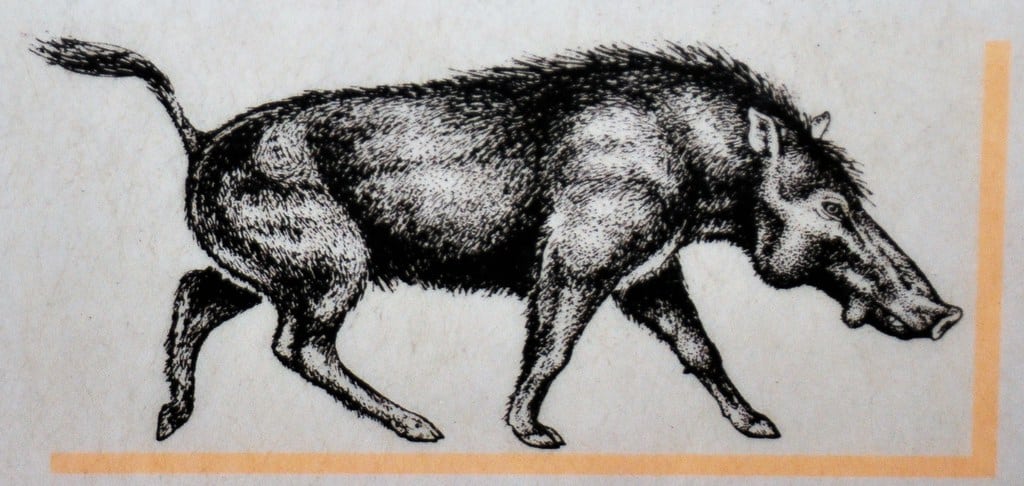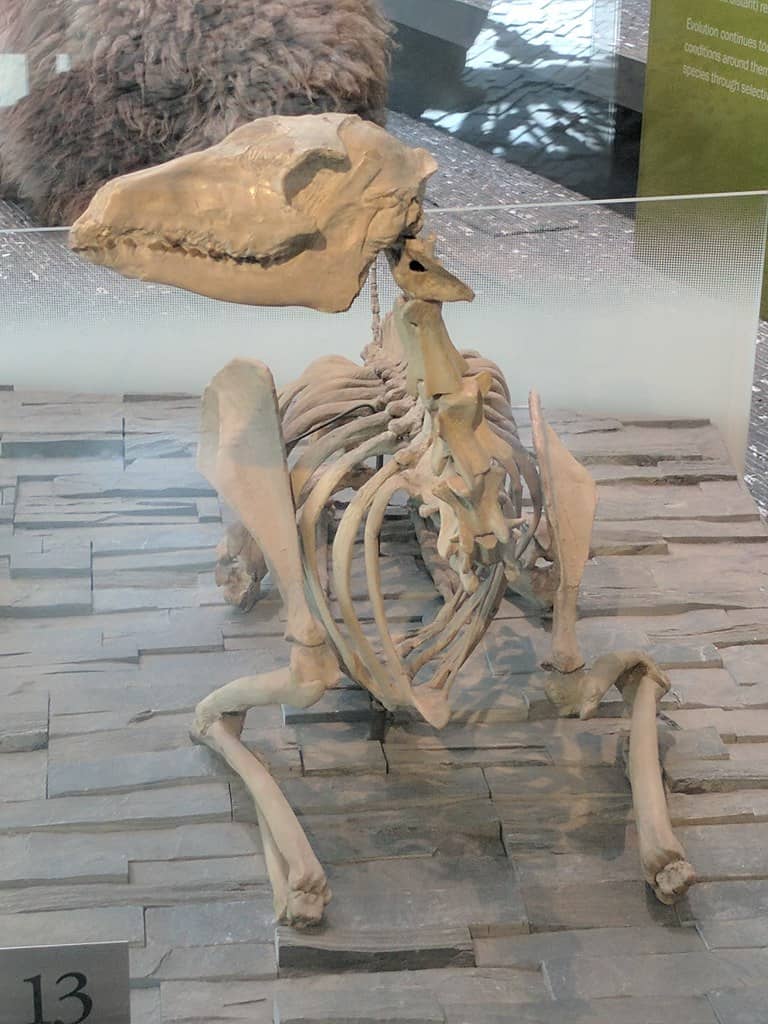Just imagine sweet Babe, the pig, but 10 times larger and hunting camels. That would give you the archaeotherium. Even though scientists compare it to the modern pig, it might be more closely related to whales and hippos. The name archaeotherium means “ancient beast” and other names for this animal include “the giant pig from hell.”
They are entelodonts – a family of now-extinct pig-like animals. They are also Artiodactylas – meaning they are even-toed ungulates like today’s giraffes, bison, and wild boars.
Aggressive and Fearsome
Even though there are a limited amount of fossils that exist for this massive ancient beast, experts have been able to glean a lot of information. Many skulls found from this animal have injuries on them, showing that they were likely aggressive and prone to battles either amongst themselves or with other animals.
Some archaeotherium skulls have puncture marks from other members of their own species, even near the eyes. These puncture wounds are up to 0.78 inches deep. Experts believe they may have had savage fights to assert social dominance or for mating purposes.
These animals would have been a sight to behold. The average archaeotherium may have weighed around 500 pounds, stood around three feet high, and measured six feet long. However, they have found skulls that indicate much larger animals than that. These huge archaeotheriums stood more than six feet tall at the shoulder and weighed over 1,000 pounds. Experts believe male and female archaeotheriums were about the same size.
For some reason, archaeotherium skulls are more commonly found than full skeletons, making it harder to estimate the full-body shape and size. However, scientists believe they were probably cow-sized and resembled a peccary — wild pig-like animals that mainly live in Central America and South America today.

Some archaeotherium weighed 1,000 and were 6 feet tall at the shoulders, approximately the size of a modern cow.
©
How Did These Giant Pigs Live?
Their giant skulls had small brains, but large olfactory areas, showing that this animal probably relied heavily on their sense of smell.
Similar to modern warthogs, the archaeotherium had large cheek protrusions. Males had larger ones than females so they were probably used either for a mating display or to house olfactory sensors for chemical communication related to mating, also similar to warthogs. These protrusions may have also offered more skull protection during battles. They may have also helped them to appear intimidating to other members of the species and other types of animals.
They also had huge jaw muscles. However, young pigs didn’t have these large muscles, only adults. Because of this, experts believe the muscular display may have been more social than functional in nature.
The archaeotherium has teeth like no other animal that exists today, although there are some similarities to modern predatory carnivores like bears. Their teeth did not have the ability to slice or cut. Instead, they likely chomped down and used their strong neck muscles to tear flesh away from their kills.
However, their teeth also show evidence of an omnivorous diet with wear patterns that likely occurred from stripping leaves off of plants.

Archaeotherium chomped down on their prey and used their strong neck muscles to tear flesh away from their kills.
©
How Did Archaeotherium Eat a Camel?
Evidence shows that archaeotherium likely ate Poebrotherium, an early camel species that lived in North America. Bite marks on the necks of poebrotherium bones have led experts to believe that archaeotherium would run next to the camels and snap at their necks to break them.
Piles of poebrotherium bones have been found together, showing that archaeotherium may have stored the carcasses for a later snacktime. Or, perhaps they were being considerate and bringing back the kill for members of the pack who were not out hunting. Once it was mealtime, they would use their strong jaw and neck muscles to cut the body in half and eat only the meaty rear section of the animal, leaving the rib cage, head, and front legs alone.

Archaeotherium ran up to poebrotherium, prehistoric camels, and killed them by breaking their necks.
©
Where and When Did Archaeotherium Live?
Archaeotheriums lived in North America for about 9 million years during the Eocene and Oligocene eras. That means they were around between 24.8 and 33.9 million years ago. Their fossils have been mostly found in the Great Plains area west of the Mississippi River and east of the Rocky Mountains. However, some fossils have also been found in Texas and Oregon.
At the time, archaeotherium would have been close to the top of the food chain. Their only possible predator would have been the hyaenodon, a large and fearsome carnivorous mammal.
Why Did They Go Extinct?
No one knows exactly why the archaeotherium and other entelodonts went extinct. However, experts believe that newer mammalian predators creating more competition for resources and a changing climate could have been large factors.
The photo featured at the top of this post is © Scott Heath / CC BY 2.0 / flickr – License / Original
FAQs (Frequently Asked Questions)
Where and when did Archaeotherium live?
Archaeotheriums lived in North America for about 9 million years during the Eocene and Oligocene eras. That means they were around between 24.8 and 33.9 million years ago. Their fossils have been mostly found in the Great Plains area west of the Mississippi River and east of the Rocky Mountains. However, some fossils have also been found in Texas and Oregon.
How did Archaeotherium eat a camel?
Evidence shows that archaeotherium likely ate Poebrotherium, an early camel species that lived in North America. Bite marks on the necks of poebrotherium bones have led experts to believe that archaeotherium would run next to the camels and snap at their necks to break them.
Thank you for reading! Have some feedback for us? Contact the AZ Animals editorial team.






